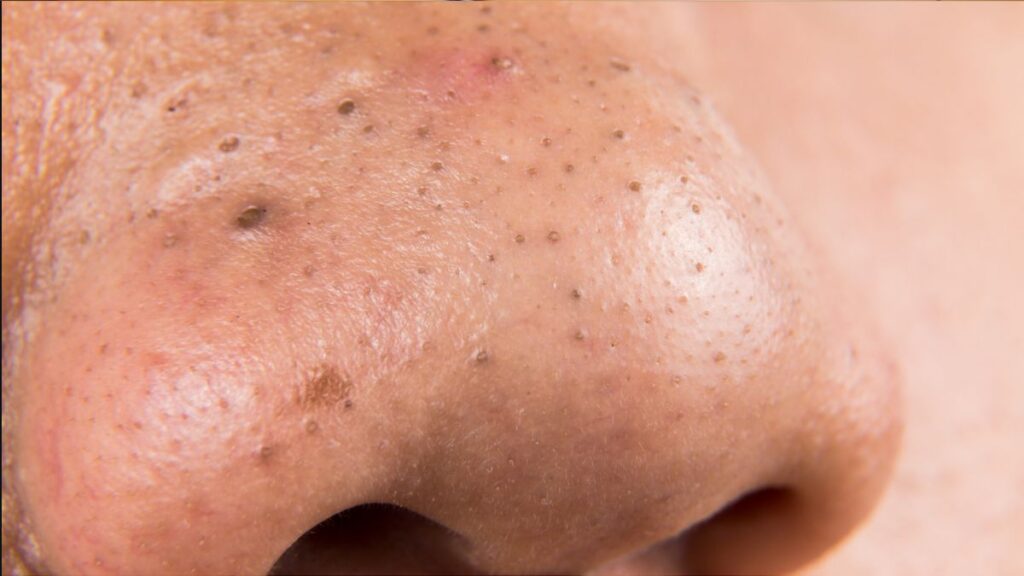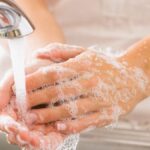Those tiny black dots scattered across your nose aren’t dirt—they’re blackheads, and nearly everyone deals with them at some point. While they might seem like a minor cosmetic concern, Blackheads on the Nose can be frustratingly persistent and affect your confidence.
The good news? With the right approach, you can effectively remove blackheads from your nose and prevent them from returning. This comprehensive guide explores everything from what causes these pesky spots to the most effective removal techniques, both professional and at-home.
What is a Blackhead
Blackheads on the Nose , medically known as open comedones, are small bumps that appear on your skin due to clogged hair follicles. Unlike whiteheads (closed comedones), blackheads remain open at the surface. When the contents of the clogged pore—a mixture of dead skin cells, oil (sebum), and bacteria—are exposed to air, they undergo oxidation, which turns them black or dark gray.
This oxidation process is similar to how a sliced apple turns brown when exposed to air. It’s important to understand that blackheads aren’t caused by dirt, and they can’t be washed away with regular soap and water. The dark appearance comes from the oxidized melanin (skin pigment) in the dead skin cells, not from poor hygiene.
Blackheads on The Nose: What Does It Mean?
The nose is particularly prone to blackheads because it’s part of the T-zone (forehead, nose, and chin), an area with a higher concentration of oil glands. These sebaceous glands produce more oil than those in other facial areas, making the nose a prime location for pore blockages.
Additionally, the pores on your nose are typically larger and more visible than those elsewhere on your face. Larger pores can more easily collect dead skin cells and sebum, leading to more noticeable blackheads. While having blackheads doesn’t necessarily indicate a serious skin condition, they can be a sign that your skin’s natural exfoliation process isn’t functioning optimally.
What Causes Blackheads on the Nose
Understanding what causes blackheads is the first step toward effective prevention and treatment. Several factors contribute to their formation:
- Excess sebum production, often triggered by hormonal changes during puberty, menstruation, or pregnancy
- Accumulation of dead skin cells that don’t shed properly
- Bacteria (specifically P. acnes) that thrive in clogged pores
- Hormonal fluctuations that increase oil production
- Certain medications that affect skin cell turnover or oil production
Other Causes
Beyond the primary biological factors, several external elements can contribute to blackhead formation:
- Environmental factors like humidity and pollution that can clog pores
- Heavy or oil-based makeup products that block pores
- Improper skincare routines, including not cleansing thoroughly
- Excessive sweating without proper cleansing afterward
- Using comedogenic (pore-clogging) skincare products
- Friction from items like helmets, tight clothing, or even your phone
Try These Tips for Instant Blackhead Removal
When you need quick results for an upcoming event or simply can’t stand those blackheads any longer, try these effective methods:
- Steam your face: Boil water, pour it into a bowl, and hold your face about 6 inches above the steam for 5-10 minutes. The steam opens your pores, making blackhead extraction easier.
- Use pore strips: Apply a pore strip to your dampened nose, let it dry completely, then carefully peel it off. These strips adhere to the oxidized sebum and pull it out as you remove the strip.
- Try a clay mask: Clay masks draw impurities from the skin. Apply to your nose, let dry according to package instructions, then rinse thoroughly.
- Chemical exfoliation: Products containing salicylic acid or glycolic acid can help dissolve the bonds between dead skin cells, allowing them to be washed away more easily.
How to Use Blackhead Tools
While professional extraction is always safest, if you choose to use blackhead removal tools at home, it’s crucial to use them correctly to avoid skin damage.
Tako Pore Blackhead Scrub Stick
This innovative tool uses gentle friction to remove blackheads and exfoliate the skin:
- Cleanse your face thoroughly and pat dry
- Dampen the stick slightly with water
- Gently roll the stick over your nose in circular motions for 1-2 minutes
- Rinse your face with cool water
- Follow with a gentle moisturizer
Blackhead Mask
Blackhead masks, particularly those containing activated charcoal or clay, can effectively draw out impurities:
- Cleanse your face and pat it until slightly damp
- Apply a thin, even layer of the mask to your nose (or entire face)
- Allow it to dry completely according to package instructions (usually 10-15 minutes)
- Gently peel off or rinse off the mask, depending on the type
- Apply a non-comedogenic moisturizer
Best Blackhead Treatments for You
Finding the right blackhead treatment depends on your skin type, severity of blackheads, and personal preferences. Here are some of the most effective options:
Facial Treatment
Professional facials are one of the most effective ways to address stubborn blackheads. Estheticians use specialized techniques and tools to safely extract blackheads without damaging your skin. They can also provide personalized advice based on your specific skin concerns.
For those with busy schedules or who prefer the comfort of their own home, consider booking an at-home facial service. This service helps you achieve a blackhead-free nose without having to deal with traffic. Simply book a facial home service through your device, and a professional therapist will come right to your door. One of the clinics offering this service is Spa Bali Moon.
Using a Salicylic Acid Blackhead Remover
Salicylic acid is a beta-hydroxy acid (BHA) that penetrates oil-filled pores and dissolves the bonds between dead skin cells. It’s particularly effective for blackhead removal because it’s oil-soluble, allowing it to work deep within pores.
For best results:
- Choose products with 1-2% salicylic acid concentration
- Apply to clean, dry skin focusing on your nose and other blackhead-prone areas
- Use once daily, gradually increasing to twice daily if your skin tolerates it well
- Always follow with sunscreen during daytime use, as BHAs can increase sun sensitivity
Wash Your Face Regularly
Consistent cleansing is fundamental to preventing blackheads. Washing your face removes excess oil, dead skin cells, and environmental pollutants before they can clog your pores.
For optimal results:
- Wash your face twice daily (morning and evening)
- Use lukewarm water—hot water can strip natural oils and stimulate more oil production
- Choose a gentle, non-comedogenic cleanser appropriate for your skin type
- Always wash after exercising to remove sweat and bacteria
- Pat your face dry instead of rubbing to avoid irritation
Get a Body Scrub
While focusing on your face is important, don’t overlook the benefits of full-body exfoliation. Dead skin cells can accumulate anywhere, and a regular body scrub helps maintain overall skin health, which can indirectly benefit your facial skin as well.
For a truly transformative experience that addresses both body and facial skin concerns, consider trying a traditional balinese body scrub. This centuries-old treatment combines natural exfoliants with nourishing ingredients to remove dead skin cells while improving circulation and promoting cellular renewal throughout your body.
Should I Be Worried?
In most cases, blackheads are a cosmetic concern rather than a medical one. However, there are situations when you might want to consult a dermatologist:
- If blackheads are accompanied by painful, inflamed acne
- When over-the-counter treatments haven’t shown improvement after 6-8 weeks
- If extraction attempts have led to infection (redness, swelling, pain, or pus)
- When blackheads are severely affecting your self-esteem or quality of life
Remember that picking or squeezing blackheads improperly can lead to scarring, infection, and even more noticeable skin problems. When in doubt, seek professional advice rather than aggressive DIY extraction.
Do I Need To See A Therapist About My Blackheads?
For persistent or severe blackhead issues, consulting a skincare professional is advisable. Here’s when to seek expert help:
Consider seeing a dermatologist if:
- Your blackheads persist despite consistent home care
- You have widespread blackheads beyond just your nose
- Blackheads are accompanied by cystic acne or other skin conditions
- You notice scarring from previous extraction attempts
Consider seeing an esthetician if:
- You want professional extraction in a spa setting
- You need guidance on establishing an effective skincare routine
- You’re interested in regular maintenance facials
- You want to explore non-prescription treatment options
Both professionals can offer valuable insights, though dermatologists can prescribe medical treatments like prescription-strength retinoids or antibiotics if necessary.
Bye Bye Blackhead on Nose
Blackheads on the Nose may be stubborn, but with consistent care and the right approach, you can significantly reduce their appearance and prevent new ones from forming. Remember that results take time—skin cell turnover typically takes 28 days, so give any new treatment at least a month before evaluating its effectiveness.
The key to long-term blackhead management is finding a balanced routine that works for your specific skin type. Combine regular cleansing, appropriate exfoliation, and targeted treatments with occasional professional care for the best results. By understanding what causes blackheads and how to address them properly, you’re well on your way to clearer, smoother skin.







